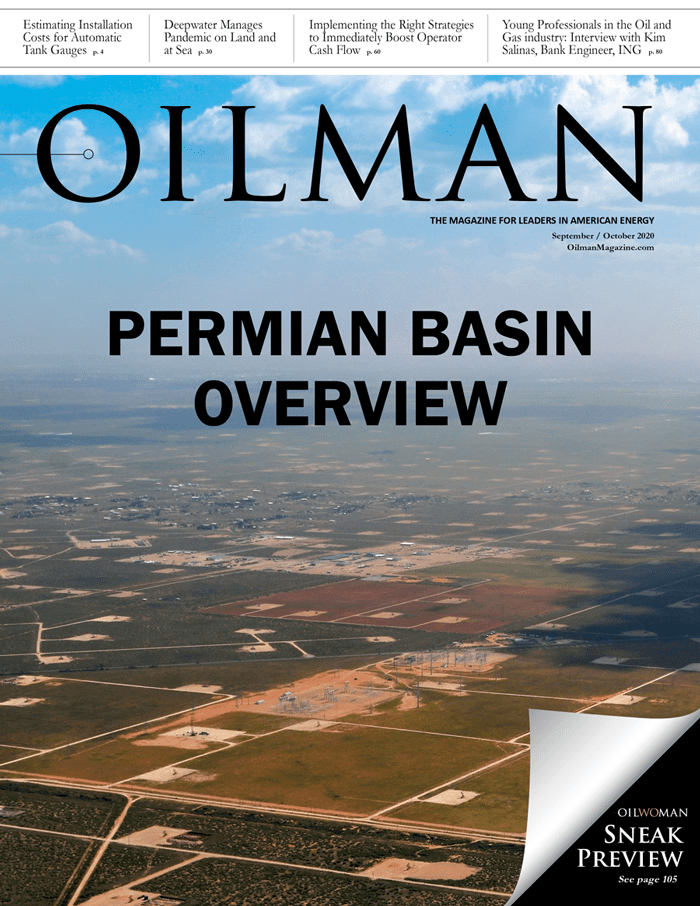We’re all searching for the good news in the good news/bad news equation right now and it can be hard to find at first glance. While remaining realistic and pragmatic, at OILMAN we also want to be optimistic and, if we know one thing about the energy industry, it’s that the people who make up the industry know how to adapt, innovate and adjust to its cyclical nature (and even something as unforeseen as COVID-19). Case in point: as employees had to respond with agility to working remotely (and, for some, the added responsibility of homeschooling), thanks to digitization and advanced technologies, many companies had their employees connected virtually within a matter of days without interrupting business.
Let’s get the bad news out of the way first. Like many industries experiencing cutbacks as result of the pandemic, the oil and gas market is no different. Just since our last issue was published in July, there has been a wave of bankruptcies in the industry, the majority of which are companies that do business in the upstream segment. According to the law firm Haynes and Boone, $55.1 billion in debt has been brought to U.S. bankruptcy courts with a total of 225 filings in the E&P market since the beginning of the year. The second quarter had the most bankruptcies since 2016. The largest oilfield service company filing for bankruptcy so far this year is Diamond Offshore Drilling with $11.8 billion in debt followed by Chesapeake Energy, a shale producer, that filed with more than $9 billion in debt.
Since March, the oil and gas industry has laid off 99,000 employees: 59,000 in Texas, 9,700 in Louisiana and 8,800 in Oklahoma. In addition, Colorado, New Mexico, California and Pennsylvania lost about 4,000 jobs each. The Bureau of Labor Statistics data indicates 44,500 jobs have been cut from oilfield service companies, 23,000 from drilling and extraction, and 16,000 from pipeline companies. Major companies, such as BP, Halliburton, Schlumberger, Baker Hughes, BJ Services and Weatherford, have eliminated employees from their payrolls. The clean energy sector also lost 27,000 jobs since May.
A gloomy 2020 indeed; however, the paycheck protection program has helped businesses, large and small, get through the early stages of the pandemic. There has been ongoing support locally to help struggling businesses and individuals with business loans, grants, rental assistance and extended unemployment benefits. Besides the $300 per week supplemental unemployment benefit President Trump authorized, Congress is discussing additional aid to businesses and working on another round of stimulus payments.
Let’s end on a brighter note and continue to look for the good news in our industry. In this issue of OILMAN, we’ve published a sneak peek to OILWOMAN Magazine. The new and exciting publication will print with OILMAN on the flip side. In OILWOMAN, we’ll profile women in a variety of roles that span the entire oil and gas industry and discuss topics in renewable energy, diversity, equity and inclusion (DEI) and workforce training. Be sure to take a look at the sneak preview and we hope you’ll be as excited as we are about the premier issue in November.
The CEO of U.S. Energy Media, Emmanuel Sullivan is a technical writer who has built up his profile in the oil and gas industry. He lives and works in Houston, where he publishes Oilman and Oilwoman on a bimonthly basis, and Energies quarterly, distributing the magazine to energy thought leaders and professionals throughout the United States and around the world. At a time when technology is rapidly changing, he provides an invaluable service to oil & gas, and renewable energy executives, engineers, and managers, offering them both broad and specific looks at the topics that affect their livelihoods. Sullivan earned his BA in Communications at Thomas Edison State University and his MA in Professional Writing at Chatham University.






